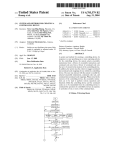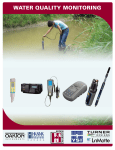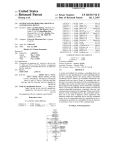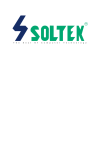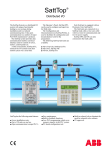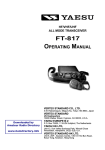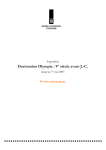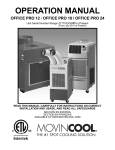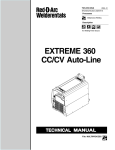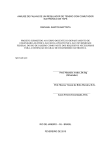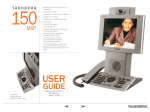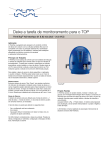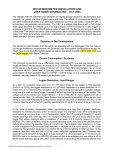Download System and method for creating a controlling device
Transcript
US 20030233664A1 (19) United States (12) Patent Application Publication (10) Pub. N0.: US 2003/0233664 A1 (43) Pub. Date: Huang et al. (54) SYSTEM AND METHOD FOR CREATING A CONTROLLING DEVICE Publication Classi?cation (51) (75) Inventors: Steve Lan-Ping Huang, Placentia, CA (US); Kim-Thoa Thi Nguyen, Yorba Linda, CA (US); Han-Sheng Yuh, Int. Cl.7 .......................... .. G05B 19/18; G06F 3/00; H04N 5/445; G06F 13/00; H04N 7/173 Walnut, CA (US); J ianJ un Cao, (52) Cypress, CA (US); My Thien Do, Anaheim, CA (US) (57) US. Cl. ........................... .. 725/132; 725/37; 725/139 ABSTRACT A system and method for creating a controlling device. In Correspondence Address: GREENBERG TRAURIG, RC. response to a user specifying one or more operating criteria for the controlling device, the system selects executable 77 WEST WACKER DRIVE CHICAGO, IL 60601-1732 (US) (73) Assignee: Universal Electronics Inc., Cypress, CA instructions from a library of executable instructions and command code sets from a library of command code sets that are to be stored in the memory of the controlling device. In addition, the system uses the criteria to suggest command key/command code mappings for use Within the controlling device. The user may interact With the system to modify the (21) Appl. No.: 10/463,153 (22) Filed: Jun. 17, 2003 selected executable instructions, command code sets, and command key/command code mappings. When stored in the memory of the controlling device, the executable instruc Related US. Application Data (63) Dec. 18, 2003 Continuation of application No. 09/716,888, ?led on Nov. 20, 2000, noW Pat. No. 6,640,144. tions are to be used to perform various operations and functions Within the controlling device and the command codes are to be transmitted from the controlling device to command the operation of controllable devices in response to activation of one or more of the command keys. Create New Project Step1: Project Setup . Assign Project Name NA Choose Project directory NEXT BACK Step2: Market and Platform ‘ CHOOSE 4 Chip Size/Model: Market Selection: USA, EURO, ASIA and OTHER Pruduct_Type Chip Size Selection: 1; 1015(sK 15K) Selection: 8K,15K,l6l<,24l<, Z 1424(16K 24K) High-End or LoweEnd .52k 4 3: 1532052,.“ 32K) NEXT BACK Step3: Mode Keys Choose Physical Modes (up to B modes) Available Mode Names: TV, CABLE, VCR, CD, SAT, AMP, TON, AUDIO, VIDEOI DVD, AUX. NEXT BACK Step4: Logical Devices Assign logical devices to mode NEXT More Modes to assign? Available Device Group: lV, CABlF, VCR, and CD. Patent Application Publication Dec. 18, 2003 Sheet 1 0f 9 ' US 2003/0233664 A1 Start i Creote New Project i Step1: Project Setup i. Assign Project Nome 2. Choose Project directory l NEXT BACK 7 <——— N Step2: Market and Platform \ CHOOSE ‘ _ ' Market Selection: USA,ond OTHER ¢- ivChip Size/Model: PFOGUCETYPG Chip Size Selection; 1. 1O16(8K,15K) i Hugh-End . Selection: or LowiEnd 52k 3: 2 1532(162'4K 32K) NEXT BACK V <—'_— St 3: M d K ep 0 e eys Available Mode Names: Choose Physical Modes (up 82%‘ gagLEiUxlcRAUgfb to 8 modes)‘ VIDEO, DVD, AUX. ——* I I Y ) NEXT BACK 7 Available Device Group: Step4: Logical Devices Assign’ logical devices to . _'_._—>- W, CABLE, VCR, 0nd CD. - mode More Modes to assign? NEXT STEP FIG. I Patent Application Publication Dec. 18, 2003 Sheet 2 0f 9 @ US 2003/0233664 A1 NEXT BACK to Step4 Stepz5 Load Coverage 4“ 1. Select Market Coverage Load Coverage: 5%—99% for each device type or use of each Market user load. 2. Select Default Mode. ‘ NEXT 4L Step6: Key Selections 1_ 56km physicm function ASSIGN Function Assignment keys. _ 2. Check selected physical keys to asslgn Secondary keys‘ DONE _ _ P'Ck functlons to Physlc‘1| keys for euch devlce type l NEXT BACK ‘__ , ' . Step7: Feature I Selections Available Optional Features: Key Mover, Macros, # Rotating Macros, _ Channel Scan, EEPROM select'oni ‘NONE, 128 Bytes, 512 optionm Feature Selections: Select desired Fav. Channel Scan, Upgrade, Bytes, 1K Bytes, 2K features for the product. Learner’ Bytes , Modem, , Back Light, Mopde Light, 7 ’ ID Lock, UEI Sleep, l NEXT BACK Double REC Key, User Reset, Video Lock, Shift 1 time, Step8: Build . . 1. (Ficgiatlgure Key Matnx for , , Shift Lock, Dedicoted Keys, Dedlcated Device, 2. Build PI'OJGCt Image. Fuclory Test’ Channel Control Lock, CH +/— Simulation Lock. HAS ERROR FIG. 2 Patent Application Publication Dec. 18, 2003 Sheet 3 0f 9 US 2003/0233664 A1 BUILD OK NO Hos Spoce Left? Increase Yes Project Lood? N0 I Reduce Project Size: Increase Project Size: Go Bock to Previous Steps 00 Book to Previous Steps or Remove ID Lood. or Add ID Lood. ADD IDs RENOVE IDs BACK“ to Previous Steps DONE DONE ID Selector Add/Remove Individual Ids from each device type BACK Step9: ?nish Display Project Con?guration. FINISH DONE FIG. 3 Patent Application Publication Dec. 18, 2003 Sheet 4 0f 9 IE] ‘Project Setup Market and PlatforinTl§j| Mode Keys US 2003/0233664 A1 Logical Devices Load Co Get Started with the UEls Fully Automated System Too|(FAST) ‘Welcome to FAST! Please follow the steps to customize your new product. w Please give a name for your new product: LRELAY V | Please choose a directory for this Project: e; |C:\PROJECTS| | (Note: a new directory will be created under this path with the name of the product‘) Nextl> FIG. 4 SEE] Project Setup ‘El Market and PlattorrnTlE] Mode Keys Logical Devices Product Target Market . —Which region is the target market? 6) USA O EUR ‘ O ASIA O OTHER — Please choose the Product Type @ Hi-End Product O Low-End Product — Please select the Chip Family and for this product: —Ol0l6 Chip——————_ OBK () 15K 01424 Chip [ 016Kv O 24K ~Oi532 Chip ®32K—44 QFP 032K-32 SOP ' O 24K-44 QFP O l6K-44 QFP O 24K~32 SOP O 1eK-_32 SOP FIG. 5 Load Patent Application Publication Dec. 18, 2003 Sheet 5 0f 9 w Project Setup US 2003/0233664 A1 Market and Platformxnigpj Mode Keyqw Logical Devices Load Mode Key Setup Please assign physical Mode Keys for the product Suggested Modes Assigned Mode Keys LEJCABLE l CABLE TV TV 00 SAT AMP TUN AUX CD VCR VIDEO AUDIO DVD m AUX ‘l ll ’ Double-click to modify Mode name Hints: Drag~Drop to Add/Remove Mode Key. Hold Ctrl key to select multiple FIG. 6 SE] Project Setup Market and PlatformTliEl Mode Keys Logical Devices LE] Load Assign Device Type to Mode Keys Please select the types for each mode key: —Choose Group to select individual typesz- @ CABLE Group OTV Group 0 VIDEO Group O AUDIO Group — Mode Key: '7 Name: [E] Default in; 00005 Change Cable Converter (0 MODE) @ Rule: Each Mode Key must have device types assigned from the same group and cannot have Video Accessories (N MODE) Satellite Receivers (8 MODE) Click “Next" to set up next Mode device types from multiple groups. IE‘ FIG. 7 Patent Application Publication Dec. 18, 2003 Sheet 6 0f 9 [El Project Setup Market and PlatformTEl Mode Keys US 2003/0233664 A1 Logical Devices Load Co ID Market Coverage Selection Please select the market coverage percentage for each device type ‘ Market 99% 7; *Note: 1. To select different ID’s coverage percentage double click the Percentage column for a Drop~Down box 99% 99% 2. Only one Dedicated Device is allowed and the device will only contain its default ID 99% 99% 3. Click "Load User ID List" button to import your to load. '1 . ‘Bed 99% 99% 99% 99% R T - Default Mode This is the mode the remote control will default to upon power-0n. Click to load ID list9 Load User ID List <l Back Nextl> FIG. 8 IE] Market and Platforrrqw Mode KeysTEl Logical DevicesTlEI Load CaverageTlEl Key Selection Physical Key Selection Please select keys for the product. The selected keys will be the physical keys on the remote Available Keys Key Label Selected Physical Keys lOutron Name ‘ 7’ Key Label lOutron Name ‘ lKlA/B, BYPASS A KEY A/B AKY [:1 IKIVOLUMN Keys VL# %ALL LIGHTS OFF ALF E] [ECHANNEL Keys CH# IEALL LIGHT ON 'KIAM ALN M U [a RECALL ElAuTo TRACK ATK ‘l — lIl E] POWER m @ENTER 1 — PWR @EIPAUSE l rl> Hold Ctrl to select multiple keys. El - l I’ Check boxes to assign secondary (shifted) keys. lSetup Outrons FIG. 9 <1Bock Ne><t|> Patent Application Publication Dec. 18, 2003 Sheet 9 of 9 US 2003/0233664 A1 Keyboard Matrix Setting Key Code and Switches Assignment Key Lists ' IXI INPUT — —> 0 1 2 3 4 5 a 7 o|sAT Hava ||c0 \|0P4 HAUX IICLR H5551 [F] 1|SETUPJ \EJT ||DwN HDP5 HEXT ||RHT HRPT Hm I 2ll’w?lREw ltUPP IIDP,6 HTUN ll 7| 7 IL | BWWWW’TIIAMPH II.‘ It | 5 lCH_+l m M [9P2 J IVIDEOI Wt |—| Ft 7lMUT llREC II I Auto Assign v It II II II II I Drag and Drop a key to assign keyscan code. m Cancel Note: 1. "Auto Assign” will automatically assign keys from the "Key Lists" to empty key boxes. 7 2. Drag a key from the list or a box and drop it to the box you waht to. If there is a key in the box already, both keys will be swapped. ' FIG. l3 Dec. 18, 2003 US 2003/0233664 A1 SYSTEM AND METHOD FOR CREATING A CONTROLLING DEVICE BACKGROUND OF THE INVENTION controlling device is intended to control, the functions intended to be supported Within the controlling device, the siZe of the memory Within the controlling device, and/or the processor chip Within the controlling device. [0001] This invention relates generally to controlling [0007] From the speci?ed criteria, the system Will select devices and, more particularly, relates to a system and method for creating a controlling device such as a universal executable instructions from a library of executable instruc tions and command code sets from a library of command remote control. code sets that are to be stored in the memory of the controlling device. In addition, the system Will suggest [0002] Controlling devices are knoWn in the art. For example, US. Pat. No. 5,689,353 discloses a universal remote control Which can be coupled via coded signals With a receiver built into various types of consumer appliances. In command key/command code mappings for use Within the controlling device. The user may interact With the system to modify the selected executable instructions, command code this manner, the universal remote control can be used to stored in the memory of the controlling device, the execut transmit a command code signal to the consumer appliances to control the operation of the consumer appliance(s) that are sets, and command key/command code mappings. When able instructions are to be used to perform various opera tions and functions Within the controlling device and the adapted to respond to the command code signal. command codes are to be transmitted from the controlling [0003] For controlling the operation of the different types device to command the operation of different types of of consumer appliances, a command code library is stored in controllable devices in response to activation of one or more the memory of the controlling device. As Will be appreci ated, a command code library is required since different consumer appliances and/or consumer appliances manufac tured by different manufacturers typically have different coding formats by Which the command codes are transmit ted. Within the command code library, the command codes of the command keys. that are transmitted using a common coding format (i.e., commands for commanding the operations of a given type of [0008] A better understanding of the objects, advantages, features, properties and relationships of the invention Will be obtained from the folloWing detailed description and accom panying draWings Which set forth an illustrative embodiment and Which are indicative of the various Ways in Which the principles of the invention may be employed. consumer appliance of a given consumer appliance manu facturer) are grouped into a command code set. [0004] It is also knoWn in the art to store executable instructions in the memory of a controlling device for use in controlling the operation and features of the controlling device. By Way of example, US. Pat. Nos. 5,959,751 and 6,014,092 disclose a universal remote control having execut able instructions that alloW a user to assign one or more command codes to a selected key. In accordance With this described feature, activation of the selected key Will cause the controlling device to transmit to the consumer appliances BRIEF DESCRIPTION OF THE DRAWINGS [0009] For a better understanding of the invention, refer ence may be had to a preferred embodiment shoWn in the folloWing draWings in Which: [0010] FIGS. 1-3 illustrate a flow chart diagram of an exemplary method by Which a controlling device can be created; [0011] FIG. 4 illustrates an exemplary screen shot by Which a user can designate a project name for the controlling the command code(s) that have been assigned to the selected device to be created in accordance With the method illus key. trated in FIGS. 1-3; [0005] Presently, creating a controlling device is a time consuming and, therefore, costly endeavor. In this regard, creating a controlling device requires the manual selection of the command codes and programming of the executable [0012] FIG. 5 illustrates an exemplary screen shot of a graphical user interface (GUI) by Which the user selects criteria for creating the controlling device in accordance With the method illustrated in FIGS. 1-3; instructions that are to be stored in the memory of the controlling device. It is also requires that the layout of the intended keyboard for the controlling device be manually created keeping in mind the proposed command code library and features to be supported by the controlling device. Manually performing these tasks suffers the disadvantage of failing to create a controlling device that adequately bal ances the needs of an end user against the development cost of the controlling device. SUMMARY OF THE INVENTION [0006] To overcome this disadvantage, the subject inven tion provides a system and method for creating a controlling device. The controlling device is created by a user specify ing one or more operating criteria for the controlling device. By Way of example, operating criteria may include the intended market for the controlling device, the intended end use of the controlling device, the types of devices the [0013] FIG. 6 illustrates an exemplary screen shot of a GUI by Which the user selects the operating modes of the controlling device to be created in accordance With the method illustrated in FIGS. 1-3; [0014] FIG. 7 illustrates an exemplary screen shot of a GUI by Which the user selects consumer appliance types for the operating modes of the controlling device to be created in accordance With the method illustrated in FIGS. 1-3; [0015] FIG. 8 illustrates an exemplary screen shot of a GUI by Which the user selects a market coverage for the consumer appliance types and speci?es a poWer-on default for the operating modes of the controlling device to be created in accordance With the method illustrated in FIGS. 1-3; [0016] FIG. 9 illustrates an exemplary screen shot of a GUI by Which the user selects the physical keys for the Dec. 18, 2003 US 2003/0233664 A1 controlling device to be created in accordance With the method illustrated in FIGS. 1-3; [0017] FIG. 10 illustrates an exemplary screen shot of a grams, objects, components, and/or data structures that perform particular tasks. While described in the context of a single computer, the computer executable instructions may GUI by Which the user maps the physical keys to functions in accordance With the method illustrated in FIGS. 1-3; be distributed among a plurality of computers connected via [0018] [0024] For performing the tasks in accordance With the computer executable instructions, the computer includes a display, a processing unit, a system memory, and a system bus that couples the system memory to the processing unit. FIG. 11 illustrates an exemplary screen shot of a GUI by Which the user selects features to be supported by the executable instructions to be included in the controlling device to be created in accordance With the method illus trated in FIGS. 1-3; [0019] FIG. 12 illustrates an exemplary screen shot of a GUI by Which the user can edit the individual command code sets to be included in the controlling device to be created in accordance With the method illustrated in FIGS. a netWork, such as the Internet. Amouse, keyboard, touch pad, joy stick, or like type of input device may be used to enter information into the computer. The system memory may include computer-readable media such as a ROM and/or RAM. The computer-readable media may also include a hard disk, a magnetic disk, and/or an 1-3; and optical disk. The computer-readable media provides non volatile storage of the computer executable instructions, data [0020] FIG. 13 illustrates an exemplary screen shot of a GUI by Which the user can edit key code and sWitch structures, program modules and other data needed to oper assignments in accordance With the method illustrated in provides a database that has a plurality of command codes ate the computer. In addition, the computer-readable media FIGS. 1-3. for controlling the operation of a plurality of different [0021] consumer appliances for a plurality of different manufactur ers and executable instructions by Which the operation and features of a controlling device may be controlled. The hard DETAILED DESCRIPTION Turning noW to the ?gures, Wherein like reference numerals refer to like elements, there is illustrated a system and method for creating a controlling device. The system and method may be used to establish a command code library, executable instructions Which implement speci?c features, and keyboard layout for the controlling device. Generally, the command code library, features, and key board layout are established as a function of the intended end use of the controlling device as Well as the processor type and memory siZe to be included in the controlling device. [0022] The command code library comprises a plurality of command codes, grouped in command code sets, that may be transmitted from the controlling device, in response to activation of a command key, to remotely control the opera disk, magnetic disk, and optical disk have associated drives that are connected to the system bus by a hard disk drive interface, a magnetic disk drive interface, and an optical disk drive interface, respectively. [0025] To create a controlling device, as illustrated in FIGS. 1-3, the user Will cause certain command codes and executable instructions to be selected from the database for storage in the memory of the controlling device as Well as select the desired processor chip, memory, and keyboard layout for the controlling device. To gain access to the computer and the database, a user may ?rst be required to log-in to the computer by providing a recogniZed ID and tion of one or more consumer appliances. Consumer appli passWord. Once a user has gained access to the computer, the computer preferably prompts the user for a project name. ances that are especially adapted for remote control include The project name may include, by Way of example, a ?le TVs, VCRs, DVD players, thermostats, fans, entry systems, name and a ?le directory. In this manner, the project can be and other like home appliances. The features of the control ling device, such as favorite key setup, macro key setup, etc., are performed in accordance With executable instructions that are used to control the operation of the controlling device itself. The command code library and executable instructions are stored in the memory (e.g., RAM, ROM, stored and, in the future, accessed and/or edited as desired. An example of a prompting screen is illustrated in FIG. 4. EEPROM) associated With the controlling device. Examples of controlling devices include universal remote controls, personal digital assistants (PDAs), expanded-function cel lular telephones and home computers. As Will be understood by those of ordinary skill in the art, the command codes that comprise the command code library may be transmitted from the controlling device to the consumer appliances by any suitable Wired or Wireless transmission means such as IR, radio frequency (RF), or the like. [0023] More speci?cally, the method that is the subject of the invention is performed in connection With a computer that is under the control of computer executable instructions. The computer need not be limited to a personal computer but [0026] For use in the process of creating the controlling device, the computer prompts the user for information pertaining to the intended end use and desired characteristics of the controlling device to be created. The initial informa tion requested of the user may include, but is not limited to, the desired target market region, the desired product type, and the desired processor chip to be included in the con trolling device, as seen in the exemplary screen shot of FIG. 5. The selection of a target market region, e.g., USA, Europe, or Asia, is used by the computer to select a subset of the plurality of the command codes stored in the database for possible inclusion in the command code library that is to be placed into the memory of the controlling device. By Way of example, selection by the user of “USA” as a target market Will cause the computer to select those command codes from the database that are used to control the opera microprocessor-based or programmable consumer electron tion of consumer appliances typically found in the United States/North America. The selection of the target market may also be used by the computer to provide an initial ics, minicomputers, mainframe computers, and the like. The computer executable instructions may include routines, pro that Will be placed on the controlling device. may include hand-held devices, multiprocessor systems, suggested mapping of command codes to command keys Dec. 18, 2003 US 2003/0233664 A1 [0027] The selection by the user of a loW-end or high-end product is also used by the computer to select a subset of executable instructions from the database corresponding to a typical feature set for that class of product, for possible storage in the memory of the controlling device. This selection may also be used by the computer to provide an initial suggested mapping of command codes to command keys. The designation of a loW-end device versus a high-end device merely refers to the intended end use of the control ling device. As Will be appreciated, the intended end use of the controlling device has an impact on the number of features and command code/command key sets that the controlling device is expected to support. By Way of example, a high-end device (e. g., a remote control to be used in connection With a home theater) Would be expected to Will access the command code set(s) in its memory that are capable of commanding the operation of a cable converter, video accessory, and/or satellite receiver When the “cable” mode key is activated. [0031] The types of consumer appliances that may be assigned to mode keys are preferably divided into consumer appliance type groups. Examples of consumer appliance type groups include a cable device type group, TV device type group, audio device type group, and video device type group. For example, cable boxes, satellite boxes, and video accessories can be classi?ed as belonging to the “cable” group and laser disc players, DVD players and VCRs can be classi?ed as belonging to the “video” group. [0032] In keeping With the designated groupings, each have command code/command key sets for commanding the performance of a greater number of operations by the command code set that is used to control the operation of the types of consumer appliances that form a group is assigned consumer appliances and support more features than Would a loW-end device (e.g., a remote control to be packed in the a unique set up code, or “ID number.” These ID numbers are maintained in the database and, When a command code set box of a cheap television). [0028] While the memory selected by the user Will in?u is stored in the memory of the controlling device, the ID number corresponding to that command code set is also provided to the controlling device. In this manner, as Will be ence the amount of information that may be stored in the appreciated by those of skill in the art, the ID number controlling device, the type of processor chip selected by the assigned to a command code set can be input by a user of a user for use in the controlling device Will also in?uence Which features the computer may select for inclusion in the controlling device to set-up the controlling device to com mand the operation of a preferred consumer appliance When controlling device. For example, if the chip selected by the user has a QFP pin layout (having 44 pins), the controlling device can support a mode LED feature. If, hoWever, the chip selected by the user has a SOP pin layout (having 32 pins), the controlling device cannot support a mode LED feature since the SOP chip Will have an insuf?cient number of I/O pins to control the operation of the LEDs needed to support the mode LED feature. As Will be understood, the mode LED feature is used to ?ash/illuminate a LED on the controlling device to provide a user With an indication of the current mode of operation of the controlling device. Thus, in the case of a selected SOP processor chip, the computer Will not permit selection for inclusion in the memory of the controlling device those executable instructions needed to implement the mode LED feature. [0029] For determining Which modes of operation the controlling device Will support, the user is prompted to the corresponding mode of operation is active. Typically, for use in setting up the controlling device, the user is provided, in a user’s manual or the like, With a list of ID numbers and the model number/manufacturer of the consumer appliance that the command code set corresponding to the ID number is intended to control. For reasons that Will be explained in greater detail beloW, it is also preferred that command code sets Within a group be arranged in a sequential order based upon the descending popularity of the consumer appliances intended to be controlled by each command code set. Such popularity order may be determined from installed base data, consumer surveys, sales statistics, or the like. In a preferred embodiment, this order is maintained via a sepa rate cross-reference to permit adjustments to be made from time to time as popularity changes. This additionally alloWs separate lists to be maintained for each market, since a given command code set may not enjoy equal popularity in every select one or more modes from a displayed list of available geographical region. modes for the controlling device. As Will be appreciated by those of skill in the art, the placing of the controlling device [0033] When a sequential assignment of ID numbers to command code sets Within a device type group is used, types into a particular mode causes the controlling device to access designated command code sets from the command of consumer appliances Within a single group can be code library stored in the memory of the controlling device. The controlling device may be placed into a particular mode selected for inclusion under a single physical mode key Without creating an ambiguity. HoWever, since the selection of types of consumer appliances from different device type in response to the activation of a mode key placed on the groups can create problems in the set-up mode of the keyboard of the controlling device. To select Which physical mode keys the controlling device Will support, as illustrated controlling device, the computer should prevent users from placing device types from different groups under a single mode key during the controlling device creation process. For in the exemplary screen shot of FIG. 6, the user can either drag a mode from the “suggested modes” list and drop the mode to the “assigned mode keys” list or select one or more example, the computer should not alloW a user to mix TVs and audio devices under a single “TV” mode key as it is of the modes in the “suggested modes” list and click on the “add” button. likely that both the TV group and the audio group Will have [0030] Once the user has selected Which physical mode keys the device Will include, the user then selects Which types of consumer appliances Will be capable of being controlled When a particular physical mode key is activated. By Way of example, and as illustrated in the screen shot of FIG. 7, the controlling device can be con?gured such that it “123”) such that the inclusion of both under the “TV” mode Would result in a controlling device that Would not being able to reconcile the entry of the common ID number during the TV mode set-up process. a command code set having a common ID number (e.g., [0034] To ?nish the initial process of selecting the com mand codes that are to be included in the command code Dec. 18, 2003 US 2003/0233664 A1 library, the user is prompted to select a desired market coverage. An exemplary screen shot of an appropriate prompt is illustrated in FIG. 8. The market coverage is the percentage of the installed base of a type of consumer appliance that the controlling device is expected to support. The user is expected to select a desired market coverage for each type of product in each mode that the user previously selected. By way of example, if the user selects 95% for consumer appliances of the type TV, the user is requesting that the computer include enough command code sets in the command code library such that 95 out of every 100 TV sets currently in use by consumers in the selected target market region (e.g., USA) would be expected to be operable using the controlling device. For use in this process, the database also maintains an approximate percentage of the installed base of the consumer appliances that a given command code set is expected to operationally control. [0035] To arrive at the command code library that has the desired market coverage, the command code library is initially created with the command code sets from the database that are capable of commanding the operation of the consumer appliances of the selected type(s) within the selected market region. This command code library is then pared down to arrive at the selected percentage of coverage for the selected device type(s). Speci?cally, command code sets are eliminated from the command code library for each device type in a descending order as a function of their assigned popularity (i.e., by eliminating the command codes corresponding to less popular devices). [0036] If the user has manually edited the list of command codes as will be described in more detail later, overriding the automatic selection process, the user will be noti?ed, for example, by highlighting an consumer appliance type ?eld. In this manner, the user will be informed that a manual selection of command code sets for inclusion/exclusion in the command code library is in effect. The manual selection of command code sets may be intermixed with the auto mated method described above, with some device types con?gured manually and others automatically. It is also to select a default mode and default command code set for each device type in the selected modes. The selection of a default mode may be made using the screen shown in FIG. 8 (VIDEO in the example shown) and default command code set(s) for each mode may be made using the screen shown in FIG. 7 (Cable mode default to device ID C0003 in the example shown). If the user does not designate a command code set to be used as the default command code set for the device type(s) in the selected modes, the com mand code set that has the highest popularity should be used as the default command code set for the device type(s). This default con?guration of the controlling device may be altered by a user through commonly known set-up proce dures. [0039] Once the above-described process is completed for all of the selected types of consumer appliances in all of the selected modes, the command codes that meet the various criteria entered by the user will be those command codes that comprise the command code library. It will be appreciated that, upon completion of this process, the command code library created by the computer will include command code sets capable of commanding the operation of consumer appliances of speci?ed types typically used in a speci?ed region with a selected, approximate percentage of market coverage for the consumer appliances within the speci?ed region. [0040] In addition to creating the command code library, the user is also guided through steps for creating the key board to be included with the controlling device. To this end, the user is presented with a screen, an example of which is illustrated in FIG. 9, by which the user can drag and drop, select and add, etc. the desired physical keys from an “available key” list to a “selected physical key” list. When the controlling device is to be a universal remote control, it is preferred that some physical keys be pre-selected and in the “selected physical key” list, e.g., digit keys, volume keys, channel keys and a power key. The “available key” list may include all possible keys or may be limited by the [0037] When establishing the market coverage for types of consumer appliances capable of being commanded by the computer as a function of whether the device was designated to be a high-end or a low-end device. Once the physical keys have been de?ned as described above, activation of the “setup outrons” icons will take the user to the setup outrons screen, an example of which is illustrated in FIG. 10. An outron is a tag that is assigned to a physical key—e.g. “FFD” controlling device, a user may also select that a particular consumer appliance type is to have a dedicated command code set. To this end, the user may selected that that desired for the physical key which is to be labeled “Fast Forward”, or “PWR” for the physical key that is to be labeled “Power”, on the completed remote control. (It will be appreciated that type of device is to be operated in the dedicated mode. In connection with this selection, the user will designate one, on the ?nal remote control product these labels may take the form of shapes or icons in place of alphanumerics, such as “>>” for “Fast Forward”) The outron tags are used to possible for an explicit user-provided list of ID numbers to be used to create the command code library, via the “load user ID list” icon shown in FIG. 8 unchangeable command code set, preferably by its assigned ID number, for inclusion in the command code library for associate each physical key with its speci?c command the given type of device. For example, if the controlling device is to be shipped with a speci?c product (e.g., VCR), function for each of the consumer appliance types selected by the user, in the manner described below. the command code library for the mode corresponding to the type of device may be con?gured to include only the command code set(s) that control the operation of the speci?c product. In this manner, a dedicated VCR, universal [0041] To set-up the outrons, the user will interact with the computer to assign or map device functions (i.e., acts to be performed in response to the receipt of a command code) to TV and universal cable box command code library for a controlling device can be created by the computer. [0038] For designating which type of device(s) the con trolling device will be con?gured to control when it is ?rst powered-up, the user may also be provided with the ability the physical keys previously designated for the controlling device. To this end, the database preferably has a pre con?gured mapping for each device type given the criteria selected by the user (e.g., high-end/low-end and USA/Asia/ Europe). The pre-con?gured mapping is displayed to the user in an the initial outron set-up screen. The user may opt Dec. 18, 2003 US 2003/0233664 A1 functions using, for example, standard drag and drop GUI end). Preferably, all default features are pre-selected for all products. Examples of default features include, but are not techniques. limited to: to use the suggested mapping or may move/delete device [0042] More speci?cally, the illustration of FIG. 10 depicts physical keys con?gured for the controlling device in the left hand column With the command functions cur rently assigned to each key for each device type selected by the user. The column on the eXtreme right shoWs the additional command functions still available but not [0045] Direct Set-up—feature Whereby the user may set up a remote control to match the customer’s devices. Using the keypad, the user enters an ID code corresponding to the brand and model for each device type supported by the operating modes of the remote. assigned for the device type selected (in the example, the [0046] Mode Mover—feature Whereby a mode key “A” or ampli?er device type). By Way of further eXample, a designer Who Wants to change the ampli?er device to can be reassigned to a different device type than its default. For eXample, a user With no cable boX but support input selects in place of digit keys can grab DPO tWo VCRs might Want to reassign the “cable” mode key to place the remote in a second “VCR” mode. through DP9 in column “A” and drag them over to the “available but unselected” list. This action leaves keys DPO through DP9 blank in the “A” column (i.e., no functions assigned thereto). The user can then select input sWitching functions from the pool of available functions (e.g., “CD” and “TAPE”) and drag them into the noW blank spaces to map these functions to the selected keys. [0043] The ability to interactively assign functions to command keys on a device ID by device ID basis is also desirable. For eXample, a particular model or brand of consumer appliance may require a function that is so critical to the use of that consumer appliance that, for that device ID only, the function should be available someWhere on the keypad even if a physical key does not eXist for it. For this purpose, the screen displayed to the user can display a drop doWn list, or the like, by Which the user can select a device, by its device ID number, to place the screen in a mode by Which the user can assign functions to command keys for that device. [0044] Yet another desirable feature is the ability to assign “shifted”, or alternate, functions to certain keys. A “shifted” function on a remote control is accessed by the user pressing a “shift” key immediately prior to the function key, causing the function key in question to transmit an alternative IR command code, for eXample the “>>” key for a CD player may send a “track skip” command in the regular mode and a “disk skip” command in the “shifted” mode. This feature alloWs eXtra functions to be offered on a remote control While still retaining a reasonable total number of keys. In an alternative implementation, the user presses the “shift” key together With the function key rather than immediately prior to it, hoWever the effect is the same. Referring again to FIG. 9, during the physical key selection process any keys Which are to support shifted functions are designated via a click able check boX in the Selected Physical Key table. In the speci?c eXample shoWn, the Fast ForWard, ReWind, Play, Stop, Pause, and Record keys are so designated. Referring noW to FIG. 10, it Will be noted that these key labels are repeated at the end of the Outron Assignment table (shaded) to alloW suitable secondary functions to be assigned to them. After the user has completed the mapping of functions to command keys, signi?ed to the computer by the user click ing on the “con?rm” icon, the user is prompted to indicate Which features are desirable to be included in the controlling device. As illustrated in FIG. 11, selection of the features may be accomplished by interacting With check boXes or the like displayed to the user. The computer may cause certain features to be pre-selected as a function of the criteria previously established for the device (e.g., high-end/loW [0047] Audio Lock—feature Whereby a speci?c device is designated as the master audio control across modes of operation, such as TV, VCR, and Cable. The remote Will alWays send that device’s volume command codes in response to activation of audio command keys no matter Which of the modes the remote is in. [0048] Blink Back—feature Whereby a LED blinks the device ID number to Which the remote is cur rently set. [0049] Library Search—feature Whereby the library of command codes can be searched and used to determine if a command code set is appropriate for operating a given consumer appliance. [0050] Master Reset—feature Whereby the remote control can be returned to its default operating mode. [0051] With respect to the optional features that may be added to the remote control, certain of the check boXes related to the features may be disabled by the computer based upon the processor chip and memory chip selectable by the user (e.g., the mode LED feature or certain features that require an EEPROM). In addition, since some features are related to other features, the computer Will select related features automatically for the user (e.g., a product should have the “channel scan” feature if the “favorite channel scan” feature is selected). Certain of the features Will ask the user to set up the mode keys and/or group of keys a feature should be locked to. In this regard, locking means that the function or operation mapped to a command key Will operate across all or some of the modes of the controlling device. EXamples of features that may be included in a controlling device include, but are not limited to: [0052] CHANNEL SCAN—feature Whereby press ing a special “SCAN” key starts the remote sending “Channel Up” once every 3 seconds, until any other key is pressed. [0053] MACRO—feature Whereby a command key on remote can be programmed to cause the sending of one or more command codes. [0054] FAVORITE CHANNEL SCAN—feature by Which a user can pre-program the unit With his favorite channels Which can then be scanned through. [0055] ID LOCK—feature primarily used in OEM or Cable markets. AlloWs a particular device code (eg Dec. 18, 2003 US 2003/0233664 A1 a speci?c model cable box) to be set up at the factory various modes to be included in the controlling device as is or by the installer and locked in, so the end user illustrated by Way of example in FIG. 12. cannot change the set up for that speci?c mode. [0056] ILLUMINATED KEYPAD—feature for con trolling keypad illumination. [0057] KEYMOVER—feature Whereby a key on the keypad can be reassigned to send a different code. [0058] LEARNING—feature by Which a remote can the desired microprocessor, memory and keyboard matrix, to thereby provide a controlling device having the desired command code library and features for the intended end use of the controlling device. Thus, it Will be appreciated that the described system and method alloWs a designer to interac be “taught” a neW key function by the user, usually tively make tradeoffs betWeen chip siZe, features, coverage, by placing his original unit close to the learning number of keys, etc. during the design of a controlling device. Furthermore, the resultant executable instructions remote and pressing the button he Wants it to learn. [0059] POWER TOGGLE—feature by Which the “Power” key only turns poWer off. PoWer is turned on by pressing any digit key (i.e. selecting the channel desired). [0060] SHIFT—feature by Which one or more keys can be assigned a secondary command code. [0061] SLEEP—feature by Which the remote emu lates a “sleep” command by sending “PoWer Off” after a set interval. Interval is selected by user in 15 minute increments by repeated presses of the key. [0062] [0065] When the build is complete, the build may be doWnloaded to the memory of a controlling device, having The selection by the user of a feature Will cause the computer to select from the database for storing in the memory of the controlling device the executable instructions needed by the controlling device to perform the selected feature. [0063] In connection With selecting the features desired to be included in the controlling device, the user may choose to con?gure the physical keyboard matrix. Although the computer automatically assigns a physical crosspoint in the key matrix to every key selected as part of the process described in connection With FIG. 9, it is sometimes desir able to assign speci?c keys to particular locations in the matrix in order optimiZe printed circuit board layout and mechanical design. To this end, the user can be presented With a key matrix display, an example of Which is shoWn in FIG. 13, by Which the user can drag and drop the previously selected physical keys to arrange the location of the physical keys on the printed circuit board Which Will form part of the controlling device. At this time, the user can also command and command code library are built from an “erector set” of standardiZed, pretested, and prequali?ed modules With little or no human intervention or programming required, thereby greatly improving the reliability of the ?nal product While simultaneously reducing development and testing time. In this manner, the described system and method alloWs a controlling device to be created that is best suited for its intended end use While being developed With a savings in both time and cost. [0066] All patents discussed in this document are hereby incorporated by reference in their entirety. [0067] While speci?c embodiments of the invention have been described in detail, it Will be appreciated by those skilled in the art that various modi?cations and alternatives to those details could be developed in light of the overall teachings of the disclosure. For example, the processes described With respect to computer executable instructions can be performed in hardWare Without departing from the spirit of the invention. Accordingly, the particular arrange ment disclosed is meant to be illustrative only and not limiting as to the scope of the invention Which is to be given the full breadth of the appended claims and any equivalents thereof. What is claimed is: 1. Computer-readable instructions for interacting With a system having programming used to create a controlling device having a memory, Wherein the instructions perform steps comprising: the computer to build the command code library, executable instructions needed to operate the controlling device and perform the selected features, the device IDs, and the command code/command key maps that have been created by the above-described processes Which Will be stored in the memory of the controlling device. accepting user input Which speci?es a target market region in Which the controlling device is to be used, the user input being provided to the system to cause the [0064] During the build, the computer may provide an displaying an estimated memory utiliZation of the selected command code sets as determined by the programming indication as to an estimated memory utiliZation, or “load” that Would result from storing the build on the selected chip(s). If the load on the memory is too great, the user may elect to include a larger memory in the controlling device and/or elect to remove certain command code sets and/or features from the build. If the memory has load to spare, the user can elect to add command code sets and/or add features to the build. In this case, the user may also elect to reduce the amount of memory in the controlling device. The user programming to select command code sets from a library of command code sets as a function of the speci?ed target market region; and of the system. 2. The computer-readable instructions as in claim 1, Wherein the instructions perform the further step of display ing a graphical user interface for accepting user input. 3. The computer-readable instructions as in claim 2, Wherein the graphical user interface comprises a menu displaying selectable target market regions. 4. The computer-readable instructions as in claim 1, can effect this by returning to any of the steps previously described in conjunction With FIGS. 5 through 11 itera Wherein the instructions perform the further step of display tively, or by customiZing the load by adding or removing siZe is provided to the system for use by the programming in determining the estimated memory utiliZation. command code sets to the build, by device ID, for the ing selectable memory siZes such that a selected memory Dec. 18, 2003 US 2003/0233664 A1 5. The computer-readable instructions as in claim 1, wherein the instructions perform the further step of accept ing user input to remove command codes from the selected command code sets. 6. The computer-readable instructions as in claim 1, Wherein the instructions perform the further step of accept ing user input to add command codes to the selected command code sets. 7. The computer-readable instructions as in claim 1, Wherein the instructions perform the further step of accept ing user input to assign command codes from the selected command code sets to keys of the controlling device. 8. A system for creating a controlling device having a memory, comprising: providing a netWork enabled computing interface to remotely access a computer readable media embodying said instructions; and performing at least one of the folloWing steps via said netWork enabled computing interface; accepting user input that speci?es a target market region in Which the controlling device is to be used; receiving user selected command code sets from a library of command code sets that is remote from the control ling device as a function of the speci?ed target market region; reporting an estimated memory utiliZation of the selected command code sets; and a user interface in communication With a computer read able media to accept input that speci?es a target market region in Which the controlling device is to be used Whereby command code sets from a library of com mand code sets that are remote from the controlling device are selected as a function of the input; and a display to present an estimated memory utiliZation of the selected command code sets to the user. 9. The system as in claim 8, Wherein the user interface is remotely located With respect to the computer readable media. 10. The system as in claim 8, Wherein the display further presents information to the user that the selected command code sets are available for inclusion in the memory of the controlling device When the estimated memory utiliZation of the selected command code sets indicates that the memory can accommodate the selected command code sets. 11. The system in claim 8, Wherein the computer readable media comprises a netWork enabled softWare application such that a plurality of users may access the softWare application substantially simultaneously. 12. The system as in claim 11, Wherein the softWare notifying the user that the selected command code sets have been prepared for inclusion in the memory of the controlling device. 16. The method as in claim 15, Wherein the netWork enabled computing interface comprises a graphical user interface. 17. The method as in claim 16, Wherein the user interface is located remotely from the computer readable media. 18. Computer-readable instructions for interacting With a system having programming used to create a controlling device having a memory, Wherein the instructions perform steps comprising: accepting user input Which functions to specify to the programming of the system Which command code sets from a library of command code sets to select; and displaying an estimated memory utiliZation of the selected command code sets as determined by the programming of the system. 19. The computer-readable instructions as in claim 18, Wherein the instructions perform the further step of display ing a graphical user interface for accepting user input. 20. The computer-readable instructions as in claim 19, application is Internet accessible. 13. A method for creating a controlling device having a Wherein the graphical user interface comprises a menu memory, comprising: displaying selectable target appliances. displaying a user interface to accept input that speci?es a target market region in Which the controlling device is to be used Whereby command code sets from a library of command code sets that are remote from the con trolling device are selected as a function of the input; and displaying to the user that the selected command code sets are available for inclusion in the memory of the con trolling device When an estimated memory utiliZation of the selected command code sets indicates that the memory can accommodate the selected command code sets. 14. The method as recited in claim 13, further comprising displaying the estimated memory utiliZation of the selected command code sets. 15. Amethod for providing user access to instructions for use in creating a controlling device having a memory, comprising: 21. The computer-readable instructions as in claim 20, Wherein the instructions perform the further step of display ing selectable memory siZes such that a selected memory siZe is provided to the system for use by the programming in determining the estimated memory utiliZation. 22. The computer-readable instructions as in claim 20, Wherein the instructions perform the further step of accept ing user input to remove command codes from the selected command code sets. 23. The computer-readable instructions as in claim 20, Wherein the instructions perform the further step of accept ing user input to add command codes to the selected command code sets. 24. The computer-readable instructions as in claim 20, Wherein the instructions perform the further step of accept ing user input to assign command codes from the selected command code sets to keys of the controlling device. * * * * *

















